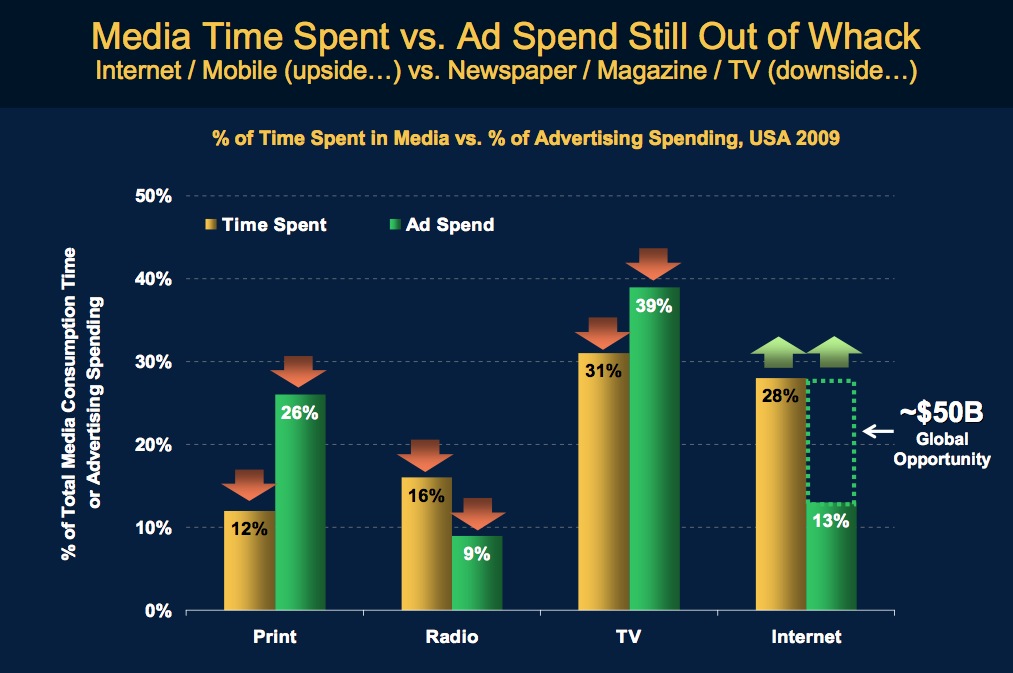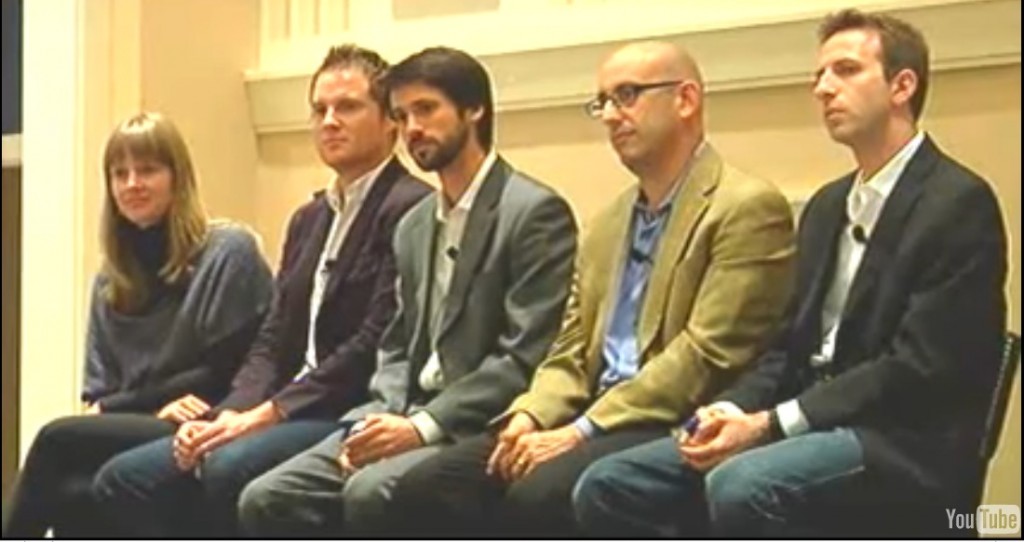Business Model Trends – The Good, The Bad, and The Ugly
March 22, 2011

Kevin Rose of Digg, Bill Gates of Microsoft, and Nathan Myhrvold of Intellectual Ventures at the TED Conference (Photo courtesy of Steve Jurvetson).
Two days before an earthquake measuring 9.0 on the Richter scale struck Japan, resulting in a devastating tsunami and near meltdown at the Fukushima nuclear power plant, we wrote on this blog about “the growing interest in nuclear power” as an alternative to coal fired power plants.
Oops!
While nuclear power-generating facilities have been greatly improved since the Fukushima reactors were built — and the prospects for nuclear energy in the future are still bright — the timing is bad. The prospects for nuclear energy in the short term have dimmed as the costs associated with using that technology are being recalculated.
That wasn’t the only thing wrong with my blog post. A reader called my attention to the case against venture capitalist Nathan Myhrvold’s company, Intellectual Ventures. Myhrvold is the former chief technology officer of Microsoft whose new company invests in technology rather than investing in companies. Intellectual Ventures buys the rights to patents it likes, then markets those patents to other firms. Or does it?
According to Mike Masnick, the prolific and outspoken editor of TechDirt, Myhrvold’s venture is not based on marketing patents but on “shaking down” companies by suing anyone using its patents without permission. Masnick accuses Intellectual Ventures of disguising its true business model by using shell companies to file the lawsuits:
[Intellectual Ventures] had decided to protect its brand name by getting other companies or creating those companies itself, giving the patent to those other companies that no one had ever heard of, and having them sue.
Ouch!
While we did praise Myhrvold’s business plan on this blog, his method for picking technologies to invest in was our focus, not his manner of collecting on those investments. However, without beating up on ourselves too much, we should point out that another company with a strikingly similar business plan has been the recipient of tremendous admiration in the media these past few weeks.
I’m speaking of ARM, the technology company behind the low-heat computer chips used in Apple’s iPhone and iPad, along with many other smartphones and tablets. The company is not bashful about its creative structure:
ARM has an innovative business model. Instead of bearing the costs associated with manufacturing, we license our technology to a network of partners, mainly leading semiconductor manufacturers and OEMs. These partners utilise our designs to create smart, low energy chips suitable for modern electronic devices.
This structure — licensing technology rather than manufacturing it — has led to a gross margin for ARM of 94%. With revenue of $631 million in 2010, ARM had a profit of $593 million. You have to envy that ratio, no matter what business you’re in.
ARM’s business model is similar to Intellectual Venture’s stated mission, yet while Myhrvold is the recipient of scorn from TechDirt and others, ARM is getting nothing but love these days. Renown technology strategist, Michael J. Fern, gushes over ARM’s business model, saying it confers “three significant advantages over Intel.”
The Wall Street Journal joined the praise parade, with University of Chicago-trained economist and new “Heard on the Street” columnist, Rolfe Winkler, noting “ARM… doesn’t have to deal with manufacturing costs or the risks of holding inventory. It’s a deeply profitable business.”
The best take on ARM’s business model, from a Minitrends perspective, comes from the recent article by Om Malik at the influential blog, GigaOM. In a post critical of Twitter’s business model, the highly-respected tech journalist compares and contrasts the business models of half-a-dozen tech companies, including Xerox, Apple, Google, and ARM. Relying heavily on the work of business guru Alex Osterwalder, Malik concludes that “the business model innovation is what turns great products into fearsome companies.”
Sometimes, the most beautiful business models can turn ugly down the road. I was teaching a workshop once when a perplexed attendee kept interrupting with questions. “How do you generate sales,” he asked. “I don’t have sales,” I answered, “I only have expenses. All I have to do is cover my expenses.”
I was describing the workings of a technology startup that made videos of businesses without charging those businesses. Costs were recouped by finding sponsors to cover the expenses. The fellow in the back of the room couldn’t understand the business model and, as it turns out, neither could investors or sponsors. An early online video play, the company died in 2008 for lack of revenue.
The clever idea of yesterday can seem brilliant or stupid a few years — or even a few days — later. That’s why, for your own Minitrends Adventure, we recommend spending as much time thinking about the business model as you do about the services or goods being sold.
STEVE O’KEEFE
News Editor, Minitrends Blog
Source: “Nathan Myhrvold on Uncovering and Investing in Technology Trends,” Mintrends Blog, March 9, 2011
Source: “Nathan Myhrvold’s Intellectual Ventures Using Over 1,000 Shell Companies To Hide Patent Shakedown,” TechDirt, Feb. 17, 2010
Source: “ARM Disrupting Intel with its Business Model?,” FernStrategy, March 10, 2011
Source: “Getting an ARM Up on Intel,” The Wall Street Journal, March 17, 2011
Source: “What Is Twitter’s Problem? No, It’s Not the Product,” GigaOM, March 8, 2011
Photo courtesy of Steve Jurvetson, used under its Creative Commons license.
TechCrunch Reveals Advances in Realtime News Technology
March 1, 2011
The “24-hour news cycle” must be on a New Year’s diet, because it’s down to about 24 minutes now. That’s about how long it takes for a breaking news story to circle the globe and get filed away.
Technology trends are fueling the every-shrinking news cycle to match the ever-shrinking attention span of the always-online news addicts. If I haven’t lost you already by exceeding 140 characters, let me quickly show you a couple of tech trends that are feeding the instant news beast.
Instagram Instant Photos
 Last Thursday (I realize that’s a long time ago), image-sharing app Instagram made its application program interface (API) available to developers to facilitate the instant sharing of photos taken by iPhone cameras. Now you can snap a picture, apply a hashtag, and upload it. Anyone watching that hashtag, or the location where you took the photo, can instantly see the new image.
Last Thursday (I realize that’s a long time ago), image-sharing app Instagram made its application program interface (API) available to developers to facilitate the instant sharing of photos taken by iPhone cameras. Now you can snap a picture, apply a hashtag, and upload it. Anyone watching that hashtag, or the location where you took the photo, can instantly see the new image.
The image above shows how the Instagram API works on the website, Foodspotting. Type in a location (i.e., Texas) and a dish (i.e., toast), and Foodspotting will show you all the pictures tagged “toast” that are geotagged from Texas. While this may seem trivial when searching for Texas toast, imagine the same search, updated in realtime by a news portal, for “protest” and “Middle East,” and you begin to get an appreciation for how fast the news is moving.
Equentia Instant News
Earlier this month (the Stone Age in realnews time), Erick Schonfeld, co-editor of TechCrunch, who has been writing about technology since pre-history (before the Web), wrote an update on Equentia, a realtime news service:
[Equentia] indexes 100,000 articles a day across blogs and news sites, puts them through a semantic engine to categorize them into every topic imaginable, and [then looks] at how much social attention each article is getting.
You can customize the search results, of course, by applying filters such as geographical regions, companies you want to follow, preferred news sources, time-span covered, product names and brand names, etc. And the news results are delivered to you along with a Twitter crawl for related subjects.
Instant Updates on Web Pages
 Speaking of Twitter crawls, widgets that allow you to show your latest Tweets and Facebook Updates have brought realtime news to plain old Web pages (you remember what those are, don’t you?).
Speaking of Twitter crawls, widgets that allow you to show your latest Tweets and Facebook Updates have brought realtime news to plain old Web pages (you remember what those are, don’t you?).
The image above shows a Twitter crawl from the Childhood Obesity News blog. You can almost see the kids getting bigger in realtime.
Web developer extraordinaire, Glen Stansberry, provides a tutorial on 10 ways to integrate Twitter into your website at Tuts+. His tutorial is old news, I realize, but not all of us are hip to the 24-second news cycle yet.
STEVE O’KEEFE
News Editor, Minitrends Blog
Source: “Instagram Unveils Realtime API With Foodspotting, Fancy, Momento, Flipboard, About.me And Others,” TechCrunch, Feb. 24, 2011
Source: “Experiments In Realtime News: The Eqentia Streams,” TechCrunch, Feb. 14, 2011
Source: “10 Awesome Ways to Integrate Twitter With Your Website,” Tuts+, Jan. 23, 2009
Images of Foodspotting and Childhood Obesity News are used under Fair Use: Commentary.
What is Social CRM? Major New Tech Trend Takes Hold
February 15, 2011
 If you haven’t heard about “Social CRM” yet, get ready. Predictions are this will be the “technology trend of the year” for 2011.
If you haven’t heard about “Social CRM” yet, get ready. Predictions are this will be the “technology trend of the year” for 2011.
Simply stated, Social CRM is the marriage of your Rolodex with Twitter. The Rolodex represents your Customer Relationship Management system, or CRM: your database of contacts, clients, prospects, employees, customers, or anyone else your organization keeps tabs on. Twitter represents the social side of these contacts, whether they express themselves on Twitter, Facebook, LinkedIn, through comments on blogs, or other ways online.
When you merge your CRM system with social networking, what you get is an amazing lifecycle understanding of how your customers were influenced to contact you, what they purchased once they did, and how those purchases worked out for them. Imagine being able to ask a customer, “How did you find out about us” and “How is that purchase working out for you” without having to ask — and being able to rely on the answers as honest and real. That’s the power of Social CRM.
Social CRM begins when an organization starts to listen to what people are saying about it online, and posts its own messages through social media such as Twitter and Facebook. Social CRM deepens when organizations go beyond watching themselves to watching their customers, employees, and other contacts. According to CRM expert and Inc. magazine reporter, Brent Leary, “2011 looks to be shaping up as the year companies go beyond focusing on marketing and promotion” with Social CRM.
Leary is on the board of the Customer Relationship Management Association and editor of its newsletter, “Insights.” His article for Inc. magazine reviews a conference on Social CRM at the University of Toronto held at the end of last year. The conference was the inaugural event for the new Center for CRM Excellence at the University’s Rotman School of Management. Leary debriefs several experts on Social CRM including Greg Gianforte at RightNow, Marcel LeBrun at Radian6, Alex Bard at Assistly, and John Bastone at SAS.
Social networking gives organizations the opportunity to eavesdrop on contacts as they reveal their opinions through actions and comments online. Social CRM gathers those tidbits of information and combines them into reports about contacts that are far more elaborate than professional profilers ever could have imagined. Social CRM makes it possible to, among other things, fix a customer’s problem before they even know they have a problem, or before they report it. That’s powerful marketing!
Another excellent article comes from Maria Ogneva at Mashable, a site not known for deep articles. Ogneva has an interest in the subject, as the director of social media for Nimble, a social relationship management firm. Still, Ogneva intelligently lays out the fundamentals of Social CRM:
The social customer may go to Twitter with a question, a user forum with a customer service query, Facebook with a compliment, or Yelp with a complaint. The processes you establish will largely determine your ability to respond quickly and with the relevant information, while uniting all of these interactions under one customer record.
If you think Social CRM is just another fad that will soon disappear, maybe Gartner will persuade you otherwise? In a study released this week, the giant IT research firm predicted that Social CRM sales will exceed $1 billion by 2013. Spending on Social CRM is expected to double this year, from 4% to 8% of total CRM spending.
Chris DiMarco, Web Editor for TMCnet, nails the significance of Gartner’s report when he writes, “The utility to include and target individuals based on information they’ve provided voluntarily on social media sites will likely be necessary to compete in the very near future.” In short, if you don’t get Social CRM, you don’t get the customer. And that’s the simple reason Social CRM is shaping up to be the app of the year for 2011.
STEVE O’KEEFE
News Editor, Minitrends Blog
Source: “2011: The Year Social CRM Goes Mainstream,” Inc., December 27, 2010
Source: “Why Your Company Needs to Embrace Social CRM,” Mashable, May 21, 2010
Source: “Gartner Says Spending on Social Software to Support Sales, Marketing and Customer Service Processes Will Exceed $1 Billion Worldwide By 2013,” Gartner news release, February 8, 2011
Source: “Social CRM to Explode in the Immediate Future says Gartner Study,” TMCnet, February 8, 2011
Image by nerissa’s ring, used under its Creative Commons license.
Meeker’s Top Internet Trends: Online Advertising Undervalued
November 17, 2010

Mary Meeker runs the global technology research team as a managing director of investment giant, Morgan Stanley. When Meeker talks, the market listens, and she was saying plenty at the recent Web 2.0 summit in San Francisco.
On Tuesday, November 16, Meeker shared her picks for the top Internet trends, backed up with some of the most cleverly crafted stats I’ve ever seen. Among the revelations: Print publications occupy only 12% of the amount of time consumers spend with media, yet account for 26% of advertising spending. This does not bode well for the future of advertiser-supported print media.
On the other hand, Meeker’s stats show that the Internet takes up 28% of people’s time for media, yet draws only 13% of advertisers’ budgets. She says there’s $50 billion too little being spent in online advertising.
Mashable’s Ben Parr summarized Meeker’s misallocation thusly: Facebook is “the most under-monitized asset in online advertising.” According to Meeker’s stats, social networking is earning a mere 55 cents per thousand impressions (CPM) from advertisers. Compare this to CPM’s of about $2.70 for the majority of websites that accept display advertising. Also grossly undervalued, according to Meeker, are display ads embedded in email, which earn only 89 cents CPM.
Parr was modest enough not to mention that Mashable ranked as one of the Top 10 brands on Twitter, coming in at position number 10 — right behind the National Basketball Association (NBA) and just ahead of Martha Stewart.
Another slide in Meeker’s presentation compared the number of people who “like” brands on Facebook with the number of viewers for popular television programs — and the CPMs associated with those TV shows. Zynga’s Texas Hold’em Poker leads the likes on Facebook with 27.2 million, which is roughly equivalent to the number of American Idol viewers. Whereas display ads on Facebook cost a mere $0.55 per thousand impressions, American Idol charges $30. We profiled Zynga founder Mark Pincus here on the Minitrends blog last month, where he talked about the importance of good eating habits.
Some of the other trends mentioned in the book, MINITRENDS, which also caught Mary Meeker’s eye, include the growth of virtual worlds. Meeker favorably compared the Japanese social networking site, Tencent (637 million active users), with Facebook (620 million annual visitors). The difference? Tencent is a virtual world using avatars. The shocking stat that caught my attention: over $1.4 billion in virtual goods have been sold on Tencent! Those are real yen shelled out for virtual merchandise such as outfits for avatars.
Another shocking stat: Seven of the top 15 Internet companies by market capitalization in 2004 are not in the top 15 today. Punishment is swift for those who do not stay on the edge of innovation. Case in point: Nokia and RIM held 70% of the smartphone market as recently as 2008. Today, that market share has dropped to 52% while Google (Android) and Apple (iPhone) have gone from nothing to gobbling up 42% of the market.
Despite a Morgan Stanley copyright notice, Mary Meeker’s slideshow seems to be everywhere online. You can find it at Mashable and TechCrunch, along with some very cursory commentary.
STEVE O’KEEFE
News Editor, Minitrends Blog
Source: “The Unprecedented Rise of Apple iOS and Other Internet Trends,” Mashable, 11/16/10
Source: “Mary Meeker On Ten Questions Internet Execs Should Ask And Answer,” TechCrunch, 11/16/10
Image from Morgan Stanley, used under Fair Use: Commentary.
Blackbaud Videos Reveal Trends in Nonprofit Technology
November 15, 2010

CLICK FOR VIDEO: Panel on Social Media for Nonprofits from the 2010 Blackbaud Conference on Nonprofit Technology
Last week, I broached the topic of how nonprofits are capitalizing on trends in technology to reach constituents through social networking. Today, I’m going to take the discussion up a notch and look at the fountainhead of many tech trends for nonprofits: Blackbaud, Inc.
Blackbaud was founded in 1981 with the purpose of providing technological support to nonprofit organizations. The company’s growth since has been phenomenal. Headquartered in Charleston, South Carolina, Blackbaud now employs more than 2,000 people worldwide. The company went public in 2004 and is traded on the NASDAQ exchange under ticker symbol BLKB.
Shortly after going public, Blackbaud hired Marc Chardon, a former CFO for Microsoft and manager of Microsoft France, as the company’s new president and CEO. Just last week, Blackbaud was named one of Forbes 100 Best Small Companies in America, a ranking based largely on exceptional financial performance.
Blackbaud has become an enormous driver of technology trends in the nonprofit sector. Last month, the company held its annual conference on nonprofit technology, drawing more than 2,200 people to Washington, D.C., for an action-packed program dominated by seminars on social networking.
This month, Blackbaud has made many of these programs available for free viewing on its BlackbaudTV channel on YouTube. These videos are both inspiring and educational for anyone interested in technology trends. Here are some of the highlights:
Global Trends and What They Mean to You
Marc Chardon, President and CEO of Blackbaud
Becoming a Networked Nonprofit: The Road to Effective Use of Social Media
Allison Fine & Beth Kanter, authors of The Networked Nonprofit
Social Media for Nonprofits
Claire Williams Diaz, Social Innovation at Twitter
Noah Everett, Founder of TwitPic
Matthew Mahan, Vice President of Impact at Causes
Geoff Livingston, Co-Founder of Zoetica
Brian Dresher, Mashable (formerly with USA Today)
Social Media: Paint by the Numbers
Holly Ross, Executive Director, NTEN: The Nonprofit Technology Network
The Nonprofit Trust Agent
Chris Brogan, New York Times bestselling co-author of Trust Agents
Most of the videos are an hour long, except for the Chris Brogan interview, which is a five-minute ambush video in the hallway of the conference center. The first video with Marc Chardon is a panel that covers such trends as social media, radical transparency, and the need for nonprofits to demonstrate ROI. The panel on social media for nonprofits is terrific, with presenters limited to five minutes to take their best shots, followed by the audience Q&A.
For access to all the BlackbaudTV videos — including a five-minute interview with Mark Zuckerberg’s engaging and articulate sister, Randi, about five things nonprofits can do to supercharge their Facebook pages — visit the BlackbaudTV page on YouTube.
STEVE O’KEEFE
News Editor, Minitrends Blog
Source: “Blackbaud Conference 2010: 5 Must-See Presentations,” Social Media 4 Nonprofits, 10/24/10
Source: “Reflections from Independent Sector and Blackbaud Conferences,” Beth’s Blog, 10/26/10.
Nonprofits Take Social Networking to New Heights
November 12, 2010
 Social networking is a megatrend that has been gaining momentum since bulletin boards first made it possible for people to schmooze online in the 1980s. Out of this megatrend have come numerous Minitrends that investors have profitably mined over the past five years, including social bookmarking, tagging, and location-based networks such as Foursquare.
Social networking is a megatrend that has been gaining momentum since bulletin boards first made it possible for people to schmooze online in the 1980s. Out of this megatrend have come numerous Minitrends that investors have profitably mined over the past five years, including social bookmarking, tagging, and location-based networks such as Foursquare.
Steve Monfort, a writer for NASDAQ.com, recently reported on the growing trend of small businesses hiring more people to handle social media:
A recent American Express survey shows that 40 percent of small businesses are using social networking to promote their offerings, up from 10 percent a year ago.
While small businesses are just warming-up to social networking, nonprofit organizations were among the earliest to embrace the trend. By now, everyone has heard about “text-to-give,” which was used by the American Red Cross to collect $30 million from cellphone users for earthquake relief in Haiti last year. According to nonprofit tech guru Tonia Zampieri, sales and marketing manager for LoyaltyClicks, a division of Smart Online, text-to-give is so 2009.
Smart Online recently conducted a survey into technology trends for nonprofit organizations. The results were reported on NTEN, the Nonprofit Technology Network, just a few days ago. They indicate that over 90% of nonprofits actively use social networking (compared with only 40% of small businesses, according to American Express). The breakdown: 91% use Facebook, 63% use Twitter, 45% use YouTube, and 35% use LinkedIn.
You would think that level of penetration would be cheered by the nonprofit experts at LoyaltyClicks. But Zampieri has found a weakness in charity tech: mobile myopia. She writes:
[O]nly 16% of the surveyed nonprofits plan on having mobile websites in 2011, while 19% plan on having smartphone applications.
Zampieri cites a Nielson study that almost one-quarter of the time people are online is spent using social networks — and that half of that social networking is done with mobile devices. Then she provides “compelling reasons why a mobile website or a mobile application might work better for your organization” than, for example, old-fashioned text-to-give:
- donations aren’t limited to $5 or $10
- donations are received immediately
- you capture and control crucial data about your donors
- any size charity can use this technology, not just giants
- it’s a permanent tool, not just a one-shot appeal
For inspiring examples about the way nonprofit organizations are innovating with social networking, we recommend a recent Mashable story on “5 Must-Follow Non-Profits Making a Difference With Social Media.” The article is a run-up to the annual Mashable Awards which will be held January 6, 2011, at the Consumer Electronics Show (CES) in Las Vegas.
I was particularly impressed by the way the Brooklyn Museum has made use of a wide variety of social networking Minitrends to engage visitors and benefactors both online and in person. The museum has a dedicated mobile site (LoyaltyClicks would approve) that allows browsers to tag the museum’s 94,000 piece collection, making it easier for visitors to locate must-see art based on other patrons’ comments. They also use Foursquare to provide restaurant suggestions and other ideas to fill out a trip to the museum.
If you have any other examples of nonprofits who are making innovative uses of social networking applications, we’d like to hear about them. And so would Mashable! The Mashable Awards are open for nomination until November 29.
STEVE O’KEEFE
News Editor, Minitrends Blog
Source: “Job growth anticipated in cloud computing, apps, social media,” NASDAQ.com News, 10/15/10
Source: “Technology Trends for Nonprofits in 2011,” NTEN, the Nonprofit Technology Network, 11/08/10
Source: “5 Must-Follow Non-Profits Making a Difference With Social Media,” Mashable, 11/06/10
Image courtesy of Lisa Brewster, used under its Creative Commons license.
The Future of Futurists Is Uncertain
October 22, 2010
In a pair of interesting articles for MIT Technology Review, one of the best futurists in the business, Tom Simonite, says the future for futurists is not what it used to be. It appears that computers might be getting better at forecasting the future than futurists are.
Simonite is no slouch when it comes to predicting trends. Not only is he the IT editor for MIT Technology Review, he’s also the online technology reporter for NewScientist. On October 4, Simonite reviewed a new search technology by startup company Recorded Future that doesn’t just find what’s out there, but what will be out there, related to any search term.
The search engine works by looking at patterns of when a company says it will release a new product, for example, compared with the actual dates of product releases. The search engine can then make predictions about when a promised new technology will actually become available. Recorded Future founder Christopher Ahlberg told Simonite how it works:
[Recorded Future uses] a constantly updated index of what Ahlberg calls ‘streaming data,’ including news articles, filings with government regulators, Twitter updates, and transcripts from earnings calls or political and economic speeches. Recorded Future uses linguistic algorithms to identify specific types of events, such as product releases, mergers, or natural disasters, the date when those events will happen, and related entities such as people, companies, and countries.
In an earlier piece for MIT Technology Review, Simonite reviewed a new search technology developed by Yahoo, called “Time Explorer.” Like Recorded Future, Time Explorer searches through articles for predictions made about the future, then plots the results on a timeline so that browsers can see what is likely to occur on any given topic in the near future.
The future for Recorded Future looks bright. The company has received funding from the venture capital arms of both Google, Inc., and the Central Intelligence Agency. Being merely human, it’s hard for me to predict when this technology will be coming to a search engine near you.
STEVE O’KEEFE
News Editor, Minitrends Blog
Source: “See the Future with a Search,” MIT Technology Review, 10/4/10
Source: “A Search Service that Can Peer into the Future,” MIT Technology Review, 8/25/10
Video courtesy Recorded Future from the company’s YouTube Channel.


